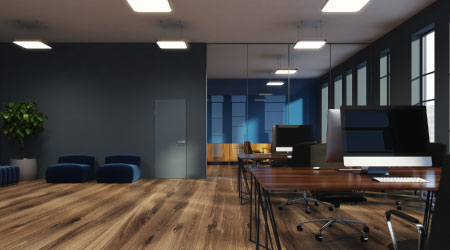Flooring: Back to Basics
A quick review of carpet and resilient flooring options is the first step to making the best choice for a space
Facility executives have a wide range of choices for floor covering. But not all types of flooring perform equally well in all applications. To make the best selection, the facility executive must understand the options available, the advantages and limitations of each and the way the flooring is to be installed.
The two primary categories of flooring that are used in new facility construction and facility renovations today are resilient flooring and carpet.
Resilient flooring materials include vinyl, rubber and natural-based products, vinyl being the most common.
Vinyl tile is still the most widely used resilient flooring material, although vinyl sheet flooring has rapidly been gaining in popularity. Tile is available in both composition and solid vinyl construction. Both resist staining and damage from oil and grease, alkaline and acids, and moisture. They are, however, susceptible to shrinkage from exposure to solvents containing naphtha or turpentine.
Resilient Choices
The lowest cost resilient floor option is composition tile, which consists of a vinyl surface with separate backing. The thickness of the vinyl material is less than that for solid vinyl tile, making it less expensive but also less durable. The use of composition vinyl tile is typically restricted to spaces where there is no extensive foot traffic.
Solid vinyl tile is a non-backed product that contains higher levels of vinyl resins, plasticizers and stabilizers than composition tile. As a result, solid vinyl tile costs more, but it also offers better resistance to abrasive wear and impact damage, making it well suited for areas of heavy foot traffic.
Both solid and composition vinyl tile are available in different sizes, with 12-inch-square, 1&Mac218;8-inch-thick tile being the most widely used. A wide range of colors and patterns makes the tile suitable for use in nearly any design. The tile color and pattern extend through the entire thickness of the vinyl rather than just being imprinted on the surface, so the tile will retain its appearance throughout its life.
Vinyl resilient sheet flooring nearly eliminates seams in the floor, improving both appearance and sanitation. Available in roll widths of 9, 12, and 15 feet, vinyl sheet flooring is field cut to fit. Seams are formed by heat-welding or bonding with liquid vinyl.
There are two types of sheet flooring commonly used today, inlaid sheet vinyl and homogeneous sheet vinyl. The former has two separate components, a vinyl wear layer and a felt backing. Commercial-grade versions of the product typically have a total thickness of 80 mils, with a vinyl wear layer of 50 mils. Homogeneous sheet vinyl is a non-layered, non-backed material typically 80 mils thick, making it one of the most durable, long-lasting types of resilient flooring. As with vinyl tile, the color and pattern of vinyl sheet flooring extend through the entire wear layer to provide a durable appearance in even high-traffic areas.
Rubber resilient floor is manufactured both as a tile and a sheet product, although tiles are far more common. Although rubber flooring has been in use for a long time, only recently has it become widely used in areas requiring a non-slip floor. That’s because a wider selection of colors and patterns is now available. Rubber flooring is not as resistant as vinyl flooring and can be damaged by exposure to oil, grease and water.
A resilient flooring material that is making a comeback today is linoleum. First introduced in the early 1900s, linoleum was replaced by vinyl products during the 1960s and 1970s. What is driving linoleum’s comeback is a combination of environmental concerns and a new generation of linoleum products. Unlike vinyl flooring, which is made with polyvinyl chloride (PVC), linoleum is made with natural materials, including linseed oil, cork or wood flour, limestone, natural pigments, resins and jute. Linoleum offers the advantages of being easy to install and durable. Its soft composition makes it comfortable underfoot while helping to absorb sound. Its primary disadvantages are that new floors give off a linseed-oil scent and that linoleum requires an annual coating of acrylic sealer. New colors and patterns being offered by manufacturers are helping to offset the widespread misconception that linoleum is cheap vinyl.
Finally, a new form of resilient flooring has recently been introduced that offers another alternative to PVC. This type of flooring is polymer-resin-based and is totally free of chlorine, is recyclable, and is free of volatile organic compounds. It offers a durable surface and is available in patterns similar to those available in high-end vinyl. It offers high resistance to stains and scuffing, and can be installed on a wide range of surfaces, including concrete, wood, stone, marble and terrazzo.
Carpet Fibers
There are three primary fibers used in carpet construction: nylon, olefin and wool. Nylon offers wear resistance, abrasion resistance and resilience. Those characteristics plus a reasonable cost make it the most widely used carpet fiber, suitable for nearly all applications.
Color is added to nylon fibers in two ways: either through solution dyeing or through beck dyeing. The color in solution-dyed fibers is added to the nylon crystals before they are processed into fibers, so the color is infused throughout the fibers. In beck dyeing, the color is added to fibers after they have been manufactured. While beck dyeing allows manufacturers to offer a wider range of colors, solution dyeing brings greater color stability and resistance to fading.
Olefin or polypropylene fibers are most frequently used in applications having special requirements, including resistance to fading from sunlight and to chemical spills. Its resistance to building up a static electrical charge makes it the carpet of choice in applications such as computer rooms, where static electricity could damage electronic equipment. Olefin fibers are not as hard as nylon fibers, nor are they as resilient. To prevent crushing, manufacturers tend to keep the pile in olefin carpets low. Olefin fibers have a relatively low melting point and can be easily damaged by friction generated by simply dragging a heavy piece of equipment across the carpet.
Of the three widely used carpet fibers, wool is the only natural fiber. It is also the most expensive and is often used in applications such as board rooms where it helps to create an appearance of elegance.
Wool fibers offer excellent resistance to crushing, matting and wear, but only moderate resistance to abrasion. While wool is excellent at hiding dirt, any dirt that does become embedded in the carpet is prone to damage the fibers by abrasion. Therefore, it is common to clean wool carpets more frequently than carpets made of synthetic fibers.
Wool fibers are easy to dye — which means a wide selection of colors and printed patterns is available — but also easy to stain. As a result, most applications that use wool carpet today are ones where the risk of staining is low.
The most common means of putting the fibers together is tufting. Tufted carpets account for more than 90 percent of all commercial applications today. In tufted carpet, loops of yarn are stitched through a backing and held in place with a latex coating. Additional backing materials, including polypropylene, jute and foam, are added for strength. Polypropylene resists mildew and is best suited for humid climates. Jute is more resilient and durable but is subject to mildew in damp applications. Foam is used primarily as a backing when carpet is glued directly to the floor.
Three types of pile are used in carpet construction: single-level loop, multi-level loop and cut pile. In carpet with single-level loop pile, all loops of yarn have tufts of the same height. Single-level pile flexes under loading, then returns to its previous position, making it well-suited for applications in heavy-traffic areas.
Multi-level loop pile has loops of yarn with tufts at two or more levels, creating a sculptured pattern. Multi-level loop pile also resists crushing under heavy traffic.
Cut pile carpet has yarn that is cut at the surface rather than looped back to the carpet. To prevent unraveling of the yarn, several plys are twisted together and heat treated. Dense packing of the tufts helps to prevent the yarn from laying over, but cut pile carpet does not withstand heavy traffic as well as loop pile.
Installation Matters
Finally, how the carpet is installed will also affect its performance. There are two type of installations: stretch-in and glue-down. The former use a separate cushion under the carpet and are held in place with tack or tackless strips installed around the edge of the installation. Stretch-in applications are suited for all types of carpet except those backed with foam.
Glue-down installation is appropriate for broadloom and tile. The floor must be in good condition for the glue to adhere. Glue-down installations are well suited for spaces subject to heavy traffic, including rolling loads.
James Piper, PE, PhD, has more than 25 years of experience in the facilities field. He is a contributing editor to Building Operating Management.
Related Topics:











